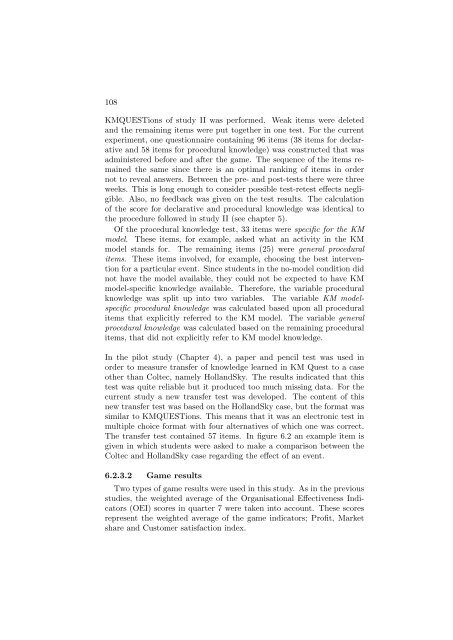The role of metacognitive skills in learning to solve problems
The role of metacognitive skills in learning to solve problems
The role of metacognitive skills in learning to solve problems
You also want an ePaper? Increase the reach of your titles
YUMPU automatically turns print PDFs into web optimized ePapers that Google loves.
108<br />
KMQUESTions <strong>of</strong> study II was performed. Weak items were deleted<br />
and the rema<strong>in</strong><strong>in</strong>g items were put <strong>to</strong>gether <strong>in</strong> one test. For the current<br />
experiment, one questionnaire conta<strong>in</strong><strong>in</strong>g 96 items (38 items for declarative<br />
and 58 items for procedural knowledge) was constructed that was<br />
adm<strong>in</strong>istered before and after the game. <strong>The</strong> sequence <strong>of</strong> the items rema<strong>in</strong>ed<br />
the same s<strong>in</strong>ce there is an optimal rank<strong>in</strong>g <strong>of</strong> items <strong>in</strong> order<br />
not <strong>to</strong> reveal answers. Between the pre- and post-tests there were three<br />
weeks. This is long enough <strong>to</strong> consider possible test-retest effects negligible.<br />
Also, no feedback was given on the test results. <strong>The</strong> calculation<br />
<strong>of</strong> the score for declarative and procedural knowledge was identical <strong>to</strong><br />
the procedure followed <strong>in</strong> study II (see chapter 5).<br />
Of the procedural knowledge test, 33 items were specific for the KM<br />
model. <strong>The</strong>se items, for example, asked what an activity <strong>in</strong> the KM<br />
model stands for. <strong>The</strong> rema<strong>in</strong><strong>in</strong>g items (25) were general procedural<br />
items. <strong>The</strong>se items <strong>in</strong>volved, for example, choos<strong>in</strong>g the best <strong>in</strong>tervention<br />
for a particular event. S<strong>in</strong>ce students <strong>in</strong> the no-model condition did<br />
not have the model available, they could not be expected <strong>to</strong> have KM<br />
model-specific knowledge available. <strong>The</strong>refore, the variable procedural<br />
knowledge was split up <strong>in</strong><strong>to</strong> two variables. <strong>The</strong> variable KM modelspecific<br />
procedural knowledge was calculated based upon all procedural<br />
items that explicitly referred <strong>to</strong> the KM model. <strong>The</strong> variable general<br />
procedural knowledge was calculated based on the rema<strong>in</strong><strong>in</strong>g procedural<br />
items, that did not explicitly refer <strong>to</strong> KM model knowledge.<br />
In the pilot study (Chapter 4), a paper and pencil test was used <strong>in</strong><br />
order <strong>to</strong> measure transfer <strong>of</strong> knowledge learned <strong>in</strong> KM Quest <strong>to</strong> a case<br />
other than Coltec, namely HollandSky. <strong>The</strong> results <strong>in</strong>dicated that this<br />
test was quite reliable but it produced <strong>to</strong>o much miss<strong>in</strong>g data. For the<br />
current study a new transfer test was developed. <strong>The</strong> content <strong>of</strong> this<br />
new transfer test was based on the HollandSky case, but the format was<br />
similar <strong>to</strong> KMQUESTions. This means that it was an electronic test <strong>in</strong><br />
multiple choice format with four alternatives <strong>of</strong> which one was correct.<br />
<strong>The</strong> transfer test conta<strong>in</strong>ed 57 items. In figure 6.2 an example item is<br />
given <strong>in</strong> which students were asked <strong>to</strong> make a comparison between the<br />
Coltec and HollandSky case regard<strong>in</strong>g the effect <strong>of</strong> an event.<br />
6.2.3.2 Game results<br />
Two types <strong>of</strong> game results were used <strong>in</strong> this study. As <strong>in</strong> the previous<br />
studies, the weighted average <strong>of</strong> the Organisational Effectiveness Indica<strong>to</strong>rs<br />
(OEI) scores <strong>in</strong> quarter 7 were taken <strong>in</strong><strong>to</strong> account. <strong>The</strong>se scores<br />
represent the weighted average <strong>of</strong> the game <strong>in</strong>dica<strong>to</strong>rs; Pr<strong>of</strong>it, Market<br />
share and Cus<strong>to</strong>mer satisfaction <strong>in</strong>dex.
















